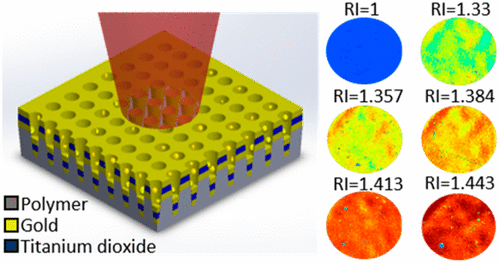Our official English website, www.x-mol.net, welcomes your
feedback! (Note: you will need to create a separate account there.)
Spectrometer-Free Plasmonic Biosensing with Metal–Insulator–Metal Nanocup Arrays
ACS Sensors ( IF 8.2 ) Pub Date : 2018-02-05 00:00:00 , DOI: 10.1021/acssensors.7b00878 Lisa P. Hackett 1 , Abid Ameen 1 , Wenyue Li 1 , Faiza Khawar Dar 1 , Lynford L. Goddard 1 , Gang Logan Liu 1
ACS Sensors ( IF 8.2 ) Pub Date : 2018-02-05 00:00:00 , DOI: 10.1021/acssensors.7b00878 Lisa P. Hackett 1 , Abid Ameen 1 , Wenyue Li 1 , Faiza Khawar Dar 1 , Lynford L. Goddard 1 , Gang Logan Liu 1
Affiliation

|
The development of high performing and accessible sensors is crucial to future point-of-care diagnostic sensing systems. Here, we report on a gold–titanium dioxide–gold metal–insulator–metal plasmonic nanocup array device for spectrometer-free refractometric sensing with a performance exceeding conventional surface plasmon resonance sensors. This device shows distinct spectral properties such that a superstrate refractive index increase causes a transmission intensity increase at the peak resonance wavelength. There is no spectral shift at this peak and there are spectral regions with no transmission intensity change, which can be used as internal device references. The sensing mechanism, plasmon–cavity coupling optimization, and material properties are studied using electromagnetic simulations. The optimal device structure is determined using simulation and experimental parameter sweeps to tune the cavity confinement and the resonance coupling. An experimental sensitivity of 800 ΔT%/RIU is demonstrated. Spectrometer-free, imaged-based detection is also carried out for the cancer biomarker carcinoembryonic antigen with a 10 ng/mL limit of detection. The high performance and distinct spectral features of this metal–insulator–metal plasmonic nanocup array make this device promising for future portable optical sensing systems with minimal instrumentation requirements.
中文翻译:

金属-绝缘体-金属纳米杯阵列的无光谱等离子生物传感
高性能和可及传感器的开发对于未来的即时医疗诊断系统至关重要。在这里,我们报道了一种用于无光谱折射技术的金-二氧化钛-金金属-绝缘体-金属等离子纳米杯阵列设备,其性能超过了传统的表面等离振子共振传感器。该装置显示出独特的光谱特性,使得上层折射率的增加导致峰值共振波长处的透射强度增加。在该峰值处没有光谱偏移,并且有没有透射强度变化的光谱区域,可以用作内部设备参考。使用电磁仿真研究了传感机制,等离激元-腔耦合优化和材料特性。使用仿真和实验参数扫描确定最佳的器件结构,以调整腔体限制和共振耦合。实验灵敏度为800Δ证明了T%/ RIU。还对癌症生物标志物癌胚抗原进行了无光谱仪,基于图像的检测,检测极限为10 ng / mL。这种金属-绝缘体-金属等离子体纳米杯阵列的高性能和独特的光谱特性使该设备有望以最少的仪器要求用于未来的便携式光学传感系统。
更新日期:2018-02-05
中文翻译:

金属-绝缘体-金属纳米杯阵列的无光谱等离子生物传感
高性能和可及传感器的开发对于未来的即时医疗诊断系统至关重要。在这里,我们报道了一种用于无光谱折射技术的金-二氧化钛-金金属-绝缘体-金属等离子纳米杯阵列设备,其性能超过了传统的表面等离振子共振传感器。该装置显示出独特的光谱特性,使得上层折射率的增加导致峰值共振波长处的透射强度增加。在该峰值处没有光谱偏移,并且有没有透射强度变化的光谱区域,可以用作内部设备参考。使用电磁仿真研究了传感机制,等离激元-腔耦合优化和材料特性。使用仿真和实验参数扫描确定最佳的器件结构,以调整腔体限制和共振耦合。实验灵敏度为800Δ证明了T%/ RIU。还对癌症生物标志物癌胚抗原进行了无光谱仪,基于图像的检测,检测极限为10 ng / mL。这种金属-绝缘体-金属等离子体纳米杯阵列的高性能和独特的光谱特性使该设备有望以最少的仪器要求用于未来的便携式光学传感系统。











































 京公网安备 11010802027423号
京公网安备 11010802027423号